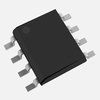-
The recommended PCB layout for the MAX9013EUA+ involves placing the device close to the power source, using a solid ground plane, and minimizing the length of the input and output traces to reduce noise and EMI.
-
To ensure the stability of the MAX9013EUA+ output voltage, it is recommended to use a minimum output capacitance of 10uF, and to place the output capacitor close to the device. Additionally, the input voltage should be well-regulated and free of noise.
-
The MAX9013EUA+ can handle input voltages up to 15V, but it is recommended to operate the device within the specified input voltage range of 4.5V to 12V for optimal performance and reliability.
-
To protect the MAX9013EUA+ from overcurrent and overheating, it is recommended to add overcurrent protection circuitry, such as a fuse or a current-limiting resistor, and to ensure good thermal conduction and heat dissipation in the PCB design.
-
The MAX9013EUA+ is rated for operation up to 125°C, but it is recommended to derate the device's performance and ensure good thermal management to prevent overheating and ensure reliability in high-temperature applications.
 MAX9013EUA+ datasheet
by Maxim Integrated Products
MAX9013EUA+ datasheet
by Maxim Integrated Products
 MAX9013EUA+ datasheet
by Maxim Integrated Products
MAX9013EUA+ datasheet
by Maxim Integrated Products